Why Federico Fellini's films are so catchy
Miscellaneous / / August 01, 2021
You will cry over the "Nights of Cabiria", appreciate the mature cynicism of "La Dolce Vita" and plunge headlong into the extravaganza of "Rome".
The great Italian director Federico Fellini, winner of five Oscars (the last one for his contribution to cinema), radically changed the thinking of both the audience and many other directors. At first glance, his paintings are wildly confusing, complex and therefore incomprehensible. But if you look at it, Fellini's cinematic language is very democratic, and he himself is a truly folk creator.
What was the creative path of Federico Fellini
Career start and neorealism
Federico Fellini began his career in cinematography in 1945 when he wrote the screenplay for Roberto Rossellini's film "Rome - an open city". This picture laid the foundation for the most democratic direction in world cinema - Italian neorealism, and is now considered an undeniable classic. The main features of neorealism were social connotations and a focus on ordinary people. To act in such tapes, along with the stars, were usually called non-professional actors.
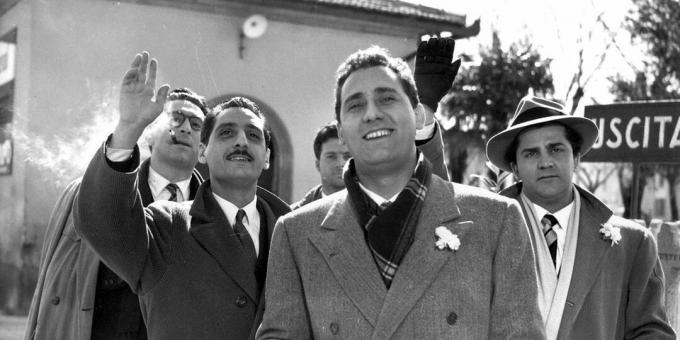
True, Fellini, unlike the main representatives of neorealism - Vittorio de Sica and Roberto Rossellini, still went his own way. The topic of the "little man" and social issues were also close to him. But already in the very first films of Federico, a creative originality and original philosophy can be traced. And the motives of the extravaganza and carnival, which later became his hallmark, are visible even in the master's early works - Variety Show Lights (1950), The White Sheikh (1952) and Mama's Sons (1953). Although in these tapes Fellini was only groping for his specific style.
Already the next films - "The Road" (1954) and "Nights of Cabiria" (1957) - became more sentimental and less realistic. They resembled a strange, disturbing dream. After them, the director finally abandoned neorealism in favor of unusual works, where reality was bizarrely combined with various kinds of miracles.
Leaving for surrealism and the flowering of creativity
A new chapter in a director's career is sometimes called rosy, or magical, realism. Films of this period are much more filled with fantasy than before, but at the same time they are distinguished by poetry and lightness. And still as much as the motives of extravaganza and carnival, Fellini is interested in the topic of finding oneself.
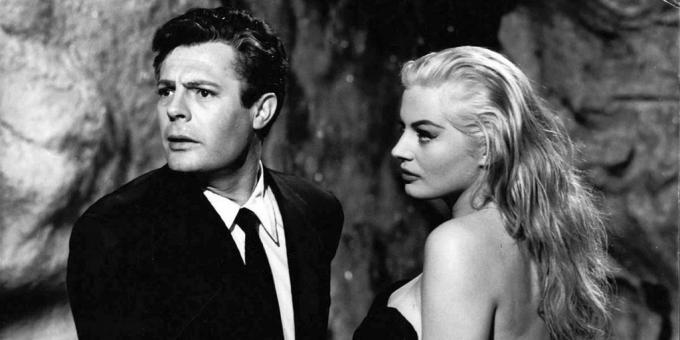
The most important tapes of this stage - "Sweet Life" (1960) and "8 and a Half" (1963) - are built as an explosive mixture of real memories, nostalgia and imagination. It is these two films that are considered the pinnacle of the director's own creativity and the standard of cinematography in general. The influence of theory is also strongly felt in them. psychoanalysis. After all, Fellini was very attentive to his dreams and wrote down many of them, and in the psychoanalytic concept, just a lot of importance is given to the interpretation of dreams.
Baroque features and increasingly grotesque style
At this stage, the creative path of the master diverges more and more from the expectations of the audience. Spectacularity finally began to dominate the plot, and the films themselves became well, completely psychedelic.
In the tapes "Satyricon" (1969), "Rome" (1972), "Amarcord" (1973) Federico Fellini refers to ancient history and even his own childhood memories. But at the same time, the films are so overloaded with details that Andrei Tarkovsky called the works of this periodTarkovsky about Fellini: "The more subjective the picture of the world, the deeper the artist penetrates into the objective reality" / Art of cinema Fellinian baroque.
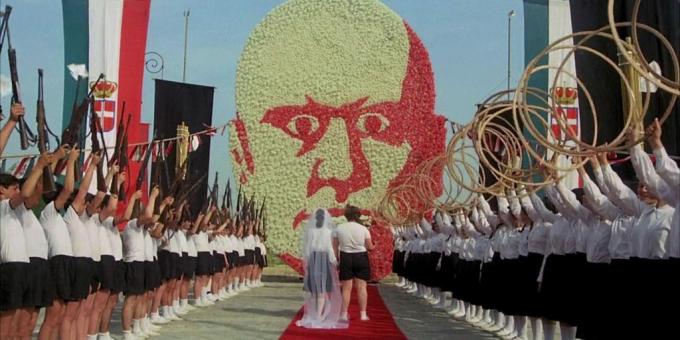
The apotheosis was the film "Casanova" (1976). He was coolly received by critics and not appreciated even by the most loyal fans of the director. And Fellini himself was not proud of this work. He took up the production with great reluctance, and read the voluminous memoirs of Giacomo Casanova after he had signed a shooting contract.
The decline of the creative path and self-irony
Starting in the 1980s, the master finally went into self-parody and rethinking his own early finds. For example, "City of Women" (1980), in fact, is a scene of the harem from "8 and a half" that has grown to the size of an entire movie.
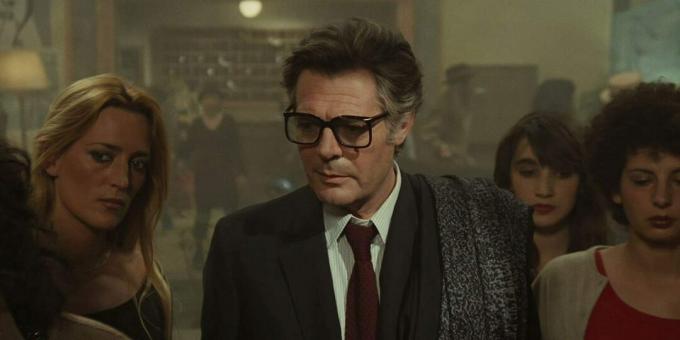
In the parable "And the ship sails ..." (1983) Fellini strictly follows his favorite artistic principles (about them below). But the director's later films - "Ginger and Fred" (1986), "Interview" (1987) and "Voice of the Moon" (1990) - are united by the theme of creative fatigue and nostalgia for the past. For the first acquaintance with Fellini, it is better not to choose them. After all, this is the very case when it is better to watch the director's films strictly in order.
How Federico Fellini's directorial style stands out
Persistent images and archetypes
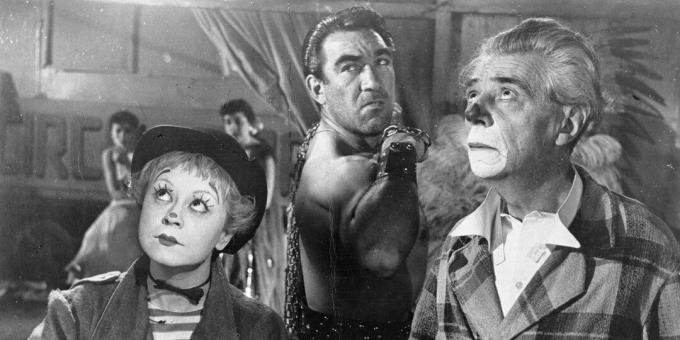
Through all of Fellini's work, the same images run like a red thread. Rarely does his film go without atmosphere. circus. The latter cannot be imagined without clowns, who simultaneously disturb and delight the director.

Federico Fellini
Producer. From the book "I, Fellini" by Charlotte Chandler
When I was seven years old, my parents took me to the circus for the first time. I was shocked by the clowns - I didn't know who they were, but I had a strange feeling that I was expected here. Since then, I have established an unbreakable connection with the circus, and I dreamed about it for many years.
The filmmaker returned to this topic so often that a similar style is now inextricably linked with his name. Critics call this aesthetics felliniesque, that is, fellinic.
Another important part of Fellini's aesthetic is the image of the beach. The director was born in the coastal town of Rimini and spent a lot of time by the sea. Therefore, in his films, fateful events for the heroes (vivid examples - "8 and a half", "Sweet life" and "The Road") often unfold on the shore.

Fellini started out as a caricaturist and was adept at depicting images on the verge of the grotesque. He wanted the characters, as soon as they appeared on the screen, to be immediately remembered by the audience. Therefore, he was worried about unusual people - marginals, prostitutes, swindlers and rogues.
One and the same image is often found in his works - a very large, stately lady. She embodies both the feminine principle, maternal care and animal passion. Like all his favorite characters, the director came up with such a heroine as a child.
Unconventional drama
Often Fellini's films are scared off by their lack of a clear narrative structure. It seems that his paintings are about nothing at all: there is no clear script in them, and the plot, even if there is one, is non-linear.
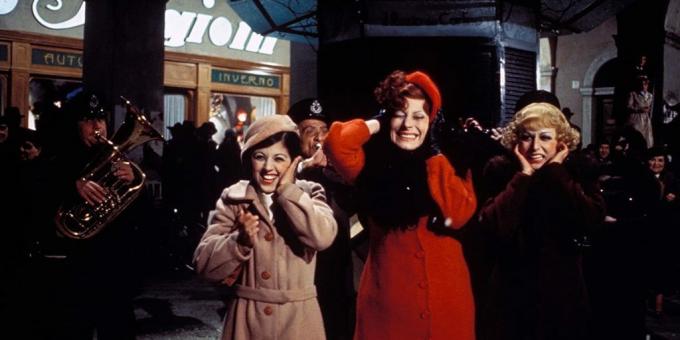
But it is precisely this feature that makes the master's ribbons so distinctive. For those who appreciate above all dashingly twisted intrigue and chic dialogues, Fellini's style is unlikely to be close. But on the other hand, the Italian perfectly knew how to convey the various shades of the feelings of his heroes.
Permanent muse
Not a single Fellini film could do without his beloved wife Juliet Mazina. Even if the actress did not act herself, she was almost always present on the set. In the film "The Road" Mazina has created one of the best images in world cinema, and the name of her heroine, Jelsomina, has become a household name.

The artist was able to convey on the screen literally the whole range of human emotions. She could be equally spontaneous, romantic, dramatic, but more often - funny and painfully touching.
Cinematic alter ego
Going to shoot "La Dolce Vita", Fellini at first could not find a leading actor. He needed the most versatile type so that the audience could easily imagine themselves in the place of the hero.
An old acquaintance of Juliet Mazina, Marcello Mastroianni, was ideal. Subsequently, his collaboration with Fellini was reborn into a close creative union, and then into a real friendship, which both carried through the years.

The director never tired of repeating that he himself and the images of Mastroianni should be taken as a whole. And thus he showed that you can shoot very unusual and interesting about yourself, and some other filmmakers later have taken this technique is put into service.
What films of Federico Fellini need to watch
1. Mom's Sons
I vitelloni
- Italy, France, 1953.
- Drama, comedy.
- Duration: 109 minutes.
- IMDb: 7.9.
Five young people are bored in the provincial seaside town. They dream of leaving their native land, where everything is painfully familiar and where their relatives live.
The basis of "Mama's Sons" was formed by the memories of Fellini himself, although he did not like when his films were called autobiographical. Nevertheless, the tape tells exactly about the director's youth. One of the main characters was even played by the brother of Federico Ricardo Fellini, and the character bears the same name.
Thanks to the very personal tone of "Mama's Sons", together with her earlier early works "Variety Show Lights" (1950) and "White Sheikh" (1952), it can be considered a kind of trilogy. But it was in "Sons" that Fellini found his creative originality and brought his cinematic skills to a new level.
Watch in iTunes →
2. Road
La strada
- Italy, 1954.
- Drama.
- Duration: 108 minutes.
- IMDb: 8.0.
The circus strongman Zampano buys out the village idiot Jelsomina to work as his assistant. Together they travel through Italy until they meet a traveling circus.
"The Road" is considered one of the key films not only in Italian, but also in world cinema. In this tape, Fellini has already departed from the canons of neorealism and added fantasy and poetry to the action.
The painting brought Fellini his first "Oscar", And also glorified Juliet Mazina, who was immediately nicknamed" Chaplin in a skirt. "
3. Nights of Cabiria
Le notti di Cabiria
- Italy, France, 1957.
- Drama, melodrama.
- Duration: 118 minutes.
- IMDb: 8.1.
A prostitute named Cabiria dreams of finding true love and leaving a poor neighborhood. But the girl is deceived and used for personal interests. Despite this, she remains kind to people.
Federico Fellini wrote the script for the film especially for his wife. Needless to say, Mazina coped with her role superbly, and her smile through tears in the finale became a symbol italian movie.
4. Sweet life
La dolce vita
- France, Italy, 1960.
- Satire, tragicomedy.
- Duration: 179 minutes.
- IMDb: 8.0.
Cynical journalist Marcello leads a hedonistic lifestyle and changes women like gloves. Even the appearance of the American film star Sylvia does not make a special impression on the hero. His feelings are hurt only by the terrible suicide of a friend, but not for long.
The picture made Marcello Mastroianni a star, and also influenced popular culture so much that even its very name became a household name. But the ingenious idea was not immediately appreciated. "Sweet Life" was banned, the director was accused of blasphemy and of allegedly filming pornography. It got to the point that Fellini literally spat in the face.
5. 8 and a half
8½
- Italy, 1963.
- Tragicomedy.
- Duration: 138 minutes.
- IMDb: 8.0.
Director Guido Anselmi is about to shoot a new film and at the same time is going through a creative crisis. He goes to a resort where he meets all sorts of people. But the further, the more the hero doubts that he will create a picture at all.
Fellini composed "8 and a Half" based on personal experience. When it was necessary to write a script, he himself faced a lack of ideas and even wanted to abandon the project. But then it occurred to him to just make a movie about himself.
Even the name "8 and a half" Federico chose not by chance. It includes six feature films and two short films, which Fellini managed to remove by this time. Well, the director considered his debut "Variety Show Lights" (1950), made in collaboration with Alberto Lattuada, as a half.
Watch in iTunes →
6. Juliet and perfume
Giulietta degli spiriti
- Italy, France, 1965.
- Fantasy, drama, comedy.
- Duration: 148 minutes.
- IMDb: 7.6.
Juliet begins to suspect her husband of treason. But from the moment when she finally loses trust in her beloved, a crowd of spirits from the other world rushes into her life.
With his first color film, Fellini wanted to give women back the right to free choice. But ironically, he did not listen at all to his wife Juliet Mazina, who constantly criticized the script during the filming, and in vain. Instead of focusing on the experience of women, Federico portrayed his own view of them on the screen. Because of this, the picture was greeted coolly, after which the director admitted that his wife was right.
Sometimes "Juliet" is called the female version of "8 and a half". This is partly true, because Fellini himself saidFederico Fellini. Make a moviethat he has been making the same film all his life.
7. Satyricon
Satyricon
- Italy, France, 1969.
- Fantasy, drama, history.
- Duration: 129 minutes.
- IMDb: 6.9.
Events unfold in the Roman Empire during its decline. In the center of the narrative is the story of the young man Encolpius. The hero is looking for his young lover, who escaped with their mutual friend.
Now "Satyricon" is considered one of the best works of Fellini, but the film, unfortunately, was far ahead of its time. Thus, experts in ancient stories The picture was harshly criticized, although the director did not claim to be authentic. Its purpose was rather a parody of the socio-political situation of the late 20th century.
The audience also reacted coldly to "Satyricon", considering it too experimental. At this stage, Fellini slowly but surely began to lose his audience, which completely ceased to understand him.
8. Rome
Roma
- Italy, France, 1972.
- Drama, comedy.
- Duration: 120 minutes.
- IMDb: 7.4.
Impressionist, written in large strokes, the story of Fellini himself, who, as a young man, moved to Rome from a small town. As in many other films of the master, it is full of autobiographical motives, while there is no clear strings, the plot is non-linear, and in the stream of consciousness, past and present, reality and fiction.
9. Amarcord
Amarcord
- Italy, France, 1973.
- Drama, comedy.
- Duration: 123 minutes.
- IMDb: 7.9.
According to the plot, the 1930s and the fascist dictatorship of Mussolini are in the yard. The main events unfold around the young Titta's family and various other strange characters inhabiting the small coastal town.
In Amarcord, Fellini reimagines his teenage years in Rimini. But he prefers to show his childhood memories through the prism of adult experience. So the film turned out to be very frank, and some episodes embarrassed the censors so much that Soviet viewers, for example, saw a cropped version.
Watch in iTunes →
10. City of women
La città delle donne
- Italy, France, 1980.
- Drama, comedy.
- Duration: 148 minutes.
- IMDb: 7.0.
The respectable bourgeois Snaporas gets off the train after the woman he likes. He finds himself in an amazing commune where there is no place for men. The hero tries to escape from there, but only plunges deeper into the abyss of chaos and absurdity.
This is one of Fellini's later films, surreal and plotless like all of his mature works. The picture can be called a rethinking of the tape "8 and a half", where the hero Mastroianni had undivided power over the ladies in love with him. But in "City of Women" the character, on the contrary, is crushed by the flow of female expression.
Read also🎥🎥🎥
- David Lynch: what makes the director unique and iconic
- James Cameron: features of creativity and the best films of the director
- How Xavier Dolan is filming - one of the most promising young directors
- Paolo Sorrentino: how the author of "Great Beauty" and "Young Pope" makes pictures
- Christopher Nolan: signature techniques of the cult director and in which films to look for them
Scientists have named the characteristic symptoms of the delta strain of coronavirus. They are different from the usual COVID-19
The authoritative scientific journal Nature wrote about the safety and effectiveness of "Sputnik V"
Scientists have shown a prototype of a protective mask that can test for coronavirus

